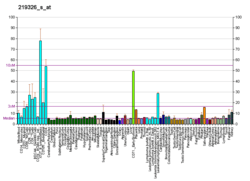B3GNT2
UDP-GlcNAc:betaGal beta-1,3-N-acetylglucosaminyltransferase 2 is an enzyme that in humans is encoded by the B3GNT2 gene.[5][6][7]
This gene encodes a member of the beta-1,3-N-acetylglucosaminyltransferase family. This enzyme is a type II transmembrane protein. It prefers the substrate of lacto-N-neotetraose, and is involved in the biosynthesis of poly-N-acetyllactosamine chains.[7]
References
- 1 2 3 GRCh38: Ensembl release 89: ENSG00000170340 - Ensembl, May 2017
- 1 2 3 GRCm38: Ensembl release 89: ENSMUSG00000051650 - Ensembl, May 2017
- ↑ "Human PubMed Reference:".
- ↑ "Mouse PubMed Reference:".
- ↑ Zhou D, Dinter A, Gutierrez Gallego R, Kamerling JP, Vliegenthart JF, Berger EG, Hennet T (Mar 1999). "A β-1,3-N-acetylglucosaminyltransferase with poly-N-acetyllactosamine synthase activity is structurally related to β-1,3-galactosyltransferases". Proc Natl Acad Sci U S A. 96 (2): 406–11. doi:10.1073/pnas.96.2.406. PMC 15149. PMID 9892646.
- ↑ Shiraishi N, Natsume A, Togayachi A, Endo T, Akashima T, Yamada Y, Imai N, Nakagawa S, Koizumi S, Sekine S, Narimatsu H, Sasaki K (May 2001). "Identification and characterization of three novel beta 1,3-N-acetylglucosaminyltransferases structurally related to the beta 1,3-galactosyltransferase family". J Biol Chem. 276 (5): 3498–507. doi:10.1074/jbc.M004800200. PMID 11042166.
- 1 2 "Entrez Gene: B3GNT2 UDP-GlcNAc:betaGal beta-1,3-N-acetylglucosaminyltransferase 2".
External links
- Human B3GNT2 genome location and B3GNT2 gene details page in the UCSC Genome Browser.
Further reading
- Amado M, Almeida R, Schwientek T, Clausen H (2000). "Identification and characterization of large galactosyltransferase gene families: galactosyltransferases for all functions". Biochim. Biophys. Acta. 1473 (1): 35–53. doi:10.1016/S0304-4165(99)00168-3. PMID 10580128.
- Ju T, Cummings RD (2003). "A unique molecular chaperone Cosmc required for activity of the mammalian core 1 β3-galactosyltransferase". Proc. Natl. Acad. Sci. U.S.A. 99 (26): 16613–8. doi:10.1073/pnas.262438199. PMC 139192. PMID 12464682.
- Strausberg RL, Feingold EA, Grouse LH, et al. (2003). "Generation and initial analysis of more than 15,000 full-length human and mouse cDNA sequences". Proc. Natl. Acad. Sci. U.S.A. 99 (26): 16899–903. doi:10.1073/pnas.242603899. PMC 139241. PMID 12477932.
- Isshiki S, Kudo T, Nishihara S, et al. (2003). "Lewis type 1 antigen synthase (beta3Gal-T5) is transcriptionally regulated by homeoproteins". J. Biol. Chem. 278 (38): 36611–20. doi:10.1074/jbc.M302681200. PMID 12855703.
- Hayashi N, Nakamori S, Okami J, et al. (2004). "Association between expression levels of CA 19-9 and N-acetylglucosamine-beta;1,3-galactosyltransferase 5 gene in human pancreatic cancer tissue". Pathobiology. 71 (1): 26–34. doi:10.1159/000072959. PMID 14555842.
- Mare L, Trinchera M (2004). "Suppression of beta 1,3galactosyltransferase beta 3Gal-T5 in cancer cells reduces sialyl-Lewis a and enhances poly N-acetyllactosamines and sialyl-Lewis x on O-glycans". Eur. J. Biochem. 271 (1): 186–94. doi:10.1046/j.1432-1033.2003.03919.x. PMID 14686931.
- Ota T, Suzuki Y, Nishikawa T, et al. (2004). "Complete sequencing and characterization of 21,243 full-length human cDNAs". Nat. Genet. 36 (1): 40–5. doi:10.1038/ng1285. PMID 14702039.
- Hillman RT, Green RE, Brenner SE (2005). "An unappreciated role for RNA surveillance". Genome Biol. 5 (2): R8. doi:10.1186/gb-2004-5-2-r8. PMC 395752. PMID 14759258.
- Gerhard DS, Wagner L, Feingold EA, et al. (2004). "The Status, Quality, and Expansion of the NIH Full-Length cDNA Project: The Mammalian Gene Collection (MGC)". Genome Res. 14 (10B): 2121–7. doi:10.1101/gr.2596504. PMC 528928. PMID 15489334.
- Zheng H, Li Y, Ji C, et al. (2005). "Characterization of a cDNA encoding a protein with limited similarity to beta1, 3-N-acetylglucosaminyltransferase". Mol. Biol. Rep. 31 (3): 171–5. doi:10.1023/B:MOLE.0000043552.32411.67. PMID 15560372.
- Liu T, Qian WJ, Gritsenko MA, et al. (2006). "Human Plasma N-Glycoproteome Analysis by Immunoaffinity Subtraction, Hydrazide Chemistry, and Mass Spectrometry". J. Proteome Res. 4 (6): 2070–80. doi:10.1021/pr0502065. PMC 1850943. PMID 16335952.
This article is issued from
Wikipedia.
The text is licensed under Creative Commons - Attribution - Sharealike.
Additional terms may apply for the media files.




